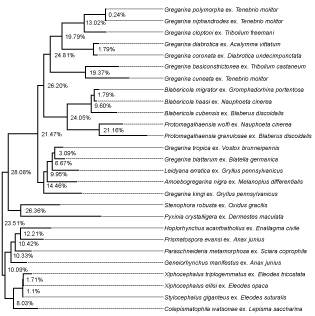Supra-specific molecular phylogeny of gregarines
Our laboratory published the first large-scale molecular analysis of septate gregarine phylogeny in 2009 in a paper entitled: Phylogenetic relationships, evolution, and systematic revision of the septate gregarines (Apicomplexa: Eugregarinorida: Septatorina). In this supra-specific work, a phylogenetic hypothesis was constructed with the use of ssu rDNA sequence data from 27 eugregarine species
parasitizing a variety of arthropod hosts and habitats. The data were used to address higher-level character transitions,
identify clades, recognize supraspecific taxonomic groups, assess the existing gregarine classification, and assess the effects
of host metabolic pattern and habitat transitions on the radiation of the septatorinid gregarines. Suprageneric character
transitions for association form, association timing, syzygy, gametocyst dehiscence, and oocyst liberation were defined. New
character search based on the proposed phylogeny produced a morphological character set that correlates strongly with the
sequence data. These morphological character sets were mapped to the new septatorinid phylogeny. Existing superfamily
groups within Septatorina were recovered and a new superfamily recognized. At the family level, the monophyly of
Actinocephalidae and Stylocephalidae was confirmed and the polyphyly of Gregarinidae was partially resolved with the
recognition of Blabericolidae. At the generic level, the monophyly of Protomagalhaensia and Xiphocephalus were confirmed,
the polyphyly of Leidyana was partially resolved with the recognition of Blabericola, and the polyphyly of Gregarina was
revealed but could not be resolved without additional taxonomic data.
High-level diversification of Septatorina resulted from
adaptations of the gametocyst, allowing colonization of both terrestrial and sweet-water habitats. Major radiations within the
group correlate with host metamorphic pattern, suggesting that evolutionarily, gregarine species track niche resources along
lines of transmission; they do not necessarily track host species in evolutionary time. Gregarine assemblages within a single
host species may be either vicariant assemblages, (i.e., products of coevolutionary, phylogenetic effects), or ecotypic
assemblages, (i.e., products of ecological fitting and host switching).
This is an on-going project. We are currently working on an expanded taxon sample of actinocephalid gregarines in an effort to resolve relationships within the group and address questions involving colonization of freshwater insect hosts and the subsequent recolonization of terrestrial hosts.
Rich Clopton is the lead researcher on this project.

